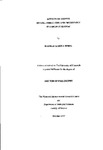EFFECTS OF COPPER ON GILL STRUCTURE AND PHYSIOLOGY IN CARCINUS MAENAS
| dc.contributor.author | HEBEL, DAGMAR KARINA | |
| dc.contributor.other | School of Biological and Marine Sciences | en_US |
| dc.date.accessioned | 2013-10-23T08:18:48Z | |
| dc.date.available | 2013-10-23T08:18:48Z | |
| dc.date.issued | 1997 | |
| dc.identifier | NOT AVAILABLE | en_US |
| dc.identifier.uri | http://hdl.handle.net/10026.1/2296 | |
| dc.description.abstract |
The effects of sublethal copper exposure at three levels of biological organisation were studied in the common shore crab Carcinus maenas (L.) (Crustacea, Decapoda). The three levels included the ultrastructure of respiratory and osmoregulatory gill tissues; ventilatory physiology (scaphognathite activity); and tissue metallothionein levels. Respiratory gill epithelia were more sensitive to sublethal copper exposure than osmoregulatory gill tissues. The cellular damage observed included severe epithelial necrosis and vacuolation, hyperplasia and haemocyte infiltration. In the respiratory gills, these changes were first present following exposure to 100 µg Cu Lˉ¹ At 500 µg Cu Lˉ¹, there was complete degeneration of the epithelia. In osmoregulatory gills, lipofuscin granules were formed at 300 µg Cu Lˉ¹. Signs of cellular damage (as observed in respiratory gills) appeared in the osmoregulatory gills only following exposure to 500 µg Cu Lˉ¹, and were restricted to areas proximal to the marginal canal. Copper concentrations below 100 µg Cu Lˉ¹ had no effect on gill tissues. This result is discussed with reference to previous studies, and related to inter-population differences and exposure techniques. Gill ultrastructural differences were observed in crabs from two estuaries with different levels of water-borne trace metals, and in crabs transplanted from the cleaner to the more polluted site. Differences included . varying densities of plasmalemmal folds and frequencies of cellular vacuolation, as well as composition and thickness of algal surface layers on the gill cuticle. Following laboratory copper exposures (500 µg Cu Lˉ¹), gill ultrastructural "damage" and tissue metallothionein levels were related to changes in scaphognathite activity. Physiological effects, including changes in scaphognathite rate and periods of apnoea, were exacerbated by increased temperature and hypoxia. Changes in scaphognathite activity and metallothionein levels were not consistent following several exposures to the same level of copper; results are discussed in relation to physiological influences. In contrast, gill ultrastructure showed consistent deterioration following exposure to 500 µg Cu Lˉ¹. Gill ultrastructure represents a reliable indicator of exposure to copper at this concentration compared to both scaphognathite activity and metallothionein concentrations. | en_US |
| dc.language.iso | en | en_US |
| dc.publisher | University of Plymouth | en_US |
| dc.title | EFFECTS OF COPPER ON GILL STRUCTURE AND PHYSIOLOGY IN CARCINUS MAENAS | en_US |
| dc.type | Thesis | |
| dc.identifier.doi | http://dx.doi.org/10.24382/3283 | |
| dc.identifier.doi | http://dx.doi.org/10.24382/3283 |
Files in this item
This item appears in the following Collection(s)
-
01 Research Theses Main Collection
Research Theses Main


